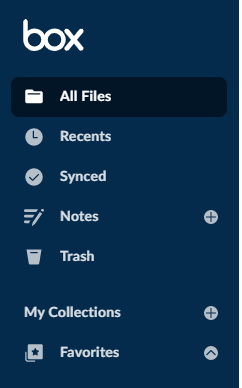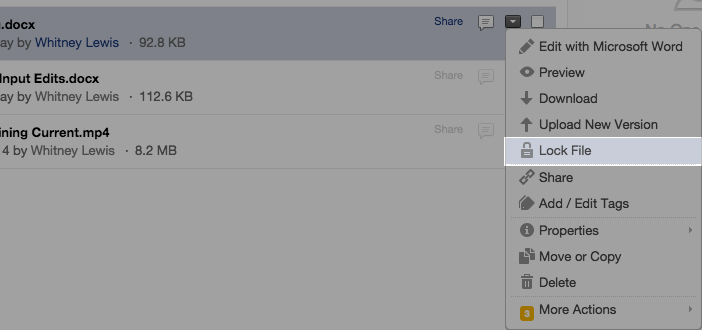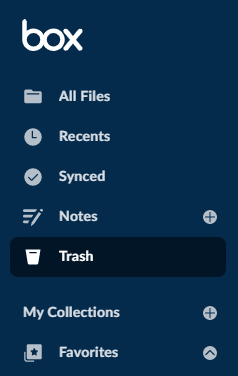The following information will help you start using Box and highlight best practices to ensure a smooth user experience while maintaining proper data security.
Table of contents
Create Your Account
- Go to box.usu.edu
- Select Continue
- Login with A number and Strong Password (if you have already logged in this step is skipped)
- Your account will automatically be created the first time you log in
- Begin sharing and collaborating with Box!
Navigating in Box
-
Search: Quickly search all of the folders and files you have with the Search Bar located in the header.

-
Updates: Click on Recents in the left side bar to get a list of new files, updates, and other notifications. This is a great way to see what has happened recently.

Uploading Content
If you're accessing Box from your web browser, there are two methods to upload files and folders:
-
Drag and Drop: In the directory that you want to add the file(s) or folder(s) to, drag the file(s) or folder(s) from your desktop (or native file browser) and drop it into the Box window. The files will be added one at a time, there will be a status bar at the bottom of the page to inform you of the progress.
NOTE: Box has a file size limit of 50 GB per file.
Naming Folders
As you use Box, you will have many collaboration folders. Establishing a naming convention with the users that you collaborate with can help to keep your folders organized.
Example 1:
Example 2:
Using Box Drive
Access your Box files and folders directly from your desktop without taking up hard drive space. Box Drive integrates with Mac Finder and Windows Explorer.
Using Box Edit
Box Edit is a feature that allows you to edit files directly in Box using an application from your computer to edit. For example, if you have a Microsoft document in your Box files and select the edit button, the file will then open in Microsoft word online or on your desktop. You can make edits, and when you close or save the file, it will automatically save the updates in Box.
Examples: DOC files open in Microsoft Word, PPT files open in Microsoft PowerPoint, images open in Photoshop (if installed), CAD files open in AutoCAD, etc.
Install Box Tools for Box Editing
For additional help see Opening and Editing Files with Box Edit
Managing Content
The following features are available to help you manage your content in Box.
-
- To lock a file, click the three dots (More options) to the right of a file, and select Lock. You will be given two options for locking the file: 1) Prevent other users from downloading this file while it is locked 2) Set an expiration time for the lock. Click on Continue once you have selected how to lock the file.

-
Version Control: Box stores up to 100 versions of a file. Whenever you upload a new version of a document or edit and save a document, you are creating a new version of that file. The version number is to the left of the file name (ex: V81) after selecting or to the right of the file name in the file list.

-
- To review version history, click on the version icon by the file name. You can download or make a past version the current version. Only the last 10 versions of a file will be available to download or make current.
-
- To restore a file, select Trash which is in the left side bar. On the file that you want to restore, click on the three dots to the right side of the file and select restore. It will be restored to the previous location with the permissions it had before.


Collaborating and Sharing Links
Box is built around collaborating and sharing files. To share a folder or file click on the Share link for the file/folder. There are three basic ways to share your files:
- Linking out to the file
- Inviting collaborators
- Embedding
Each option has the same security options. By default, when you share a file it is shared with Collaborators Only. When you share a folder/file, you have the option of setting the expiration of that share. You can specify the date that it will automatically remove the share, delete the file, or both.
- Sharing via links: A link is created when you share a file. You can give this link to collaborators or viewers to access your file/folder. This link can be public (anyone can access it), limited to just collaborators, or a self- inviting link (accessing the link will make them collaborators).
-
- You can create a Custom URL for easier links. All Custom URLs will be https://usu.box.com/CustomName. Custom URLs are first come first served.
- Embedding: You can embed a file/folder into a webpage to link to the file/folder directly. This is usually used with the download only permission.
Box is based around "least privilege access", meaning that a user should only be given access to the files/folders that they need access to and nothing more.
Sharing permissions are built with the waterfall method, meaning that when access is given to an entire folder, they will have the same permissions for any files/folders within that first folder.
Remember to only give access to the files and folders that a collaborator needs.
When a folder/file is shared, the storage space is used only by the file owner. Folders and File storage count against the file owners quota and not the collaborators storage quota.
Tasks and Comments
When you are collaborating on a file, you can add Tasks or Comments to the file and eliminate long email chains.
Comments can be left on a file from the preview screen.
Use @-mentions to notify a specific colleague.
In addition to standard comments, you can assign general and approval tasks.
Using Box Notes
Box Notes is an easy-to-use document creation tool in Box. With Box Notes, you can quickly take notes, share ideas, and collaborate in real-time with your team—all without leaving Box. The notes are web-based documents and do not require any other software in order to create, view, or edit.
Access Notes by selecting Notes in the left side bar, use the plus sign to create a new Note:
For further assistance, please contact your Department IT Support or the IT Service Desk